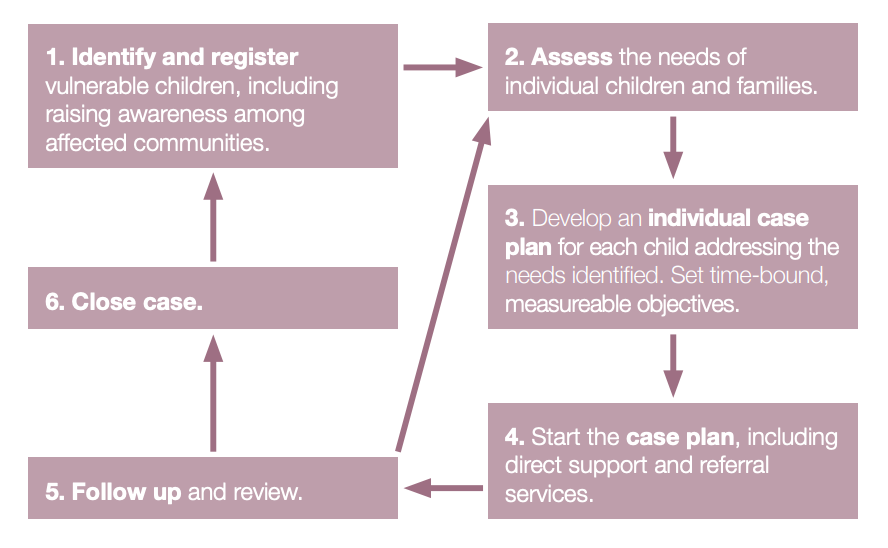What is case management?
CASE MANAGEMENT is a way of organizing and carrying out work to address an individual child’s (and their family’s) needs in an appropriate, systematic and timely manner, through direct support and/or referrals, and in accordance with a project or program’s objectives1.
Child Protection case management can be provided in emergency and development settings using social work approach to address a range of child protection concerns. Case management services can be provided as part of a strategy to reduce inter-connected risks and vulnerabilities that cause protection violation or as a response to violations that children have experienced. Having case management procedures in place ensures quality, consistency, and coordination of services.
Key Points about Case Management
- Should focus on the needs of an individual child and their family, ensuring that concerns are addressed systematically in consideration of the best interests of the child and building upon the child and family’s resilience.
- Should be provided in accordance with the established case management process, ensuring each case follows a series of steps (as shown below) involving children’s meaningful participation and family empowerment throughout.
- Involve the coordination of services and supports within an interlinked or referral system
- Require systems for ensuring the accountability of case management agencies (within a formal or statutory system where this exists).
- Are provided by one key worker (referred to as a caseworker or case manager) who is responsible for ensuring that decisions are taken in the best interests of the child, the case is managed in accordance with the established process, and who takes responsibility for coordinating the actions of all actors.
At the IRC, we use a case management approach to a various set of humanitarian issues
Core Steps of Case Management

Guiding Principles for Case Management
- Do no harm
- Prioritise the best interests of the child
- Non-discrimination
- Adhere to ethical standards
- Seek informed consent and/or informed assent
- Respect confidentiality
- Ensure Accountability
Specific Resources
The current Case management training package is the result of two years of work led by the International Rescue Committee on behalf of the Global Case Management Task Force. The project was funded by USAID/BHA. After a wide desk review, consultations with CMTF members and surveys with case management staff from 41 countries, Child Protection Case Management Training materials were updated and new content has been added. The training materials were developed through a lengthy and iterative process with feedback provided by members of the CMTF as well as pilots in Iraq, South-Sudan and Kenya.
This updated Child Protection Case Management training package includes a series of trainings to further strengthen the capacity of child protection caseworkers. Child Protection Case Management competencies are developed gradually, as well as through experience and with the support of a supervisor. To promote gradual learning and integrate supervision and coaching opportunities, these trainings are structured in three different levels:
- Level 1 Foundational training
- Level 2 Competency-based training
- Level 3 Advanced training.
It is recommended that child protection caseworkers, supervisors, and managers in humanitarian settings complete the different levels of training. The main target audience remains child protection caseworkers.
The Inter-Agency Case Management Supervision and Coaching Training package (2018) forms a complementary training within this learning and development strategy.
The Facilitator’s Guide, Level 1, Level 2 and Level 3 Child Protection Case Management training materials are available in English, French, Spanish and Arabic.
Have a look at the different resources here